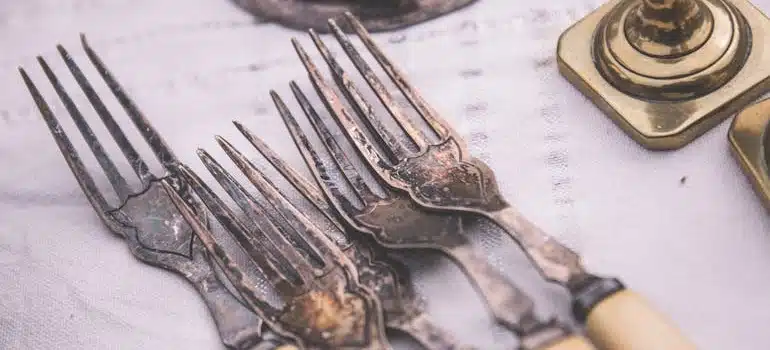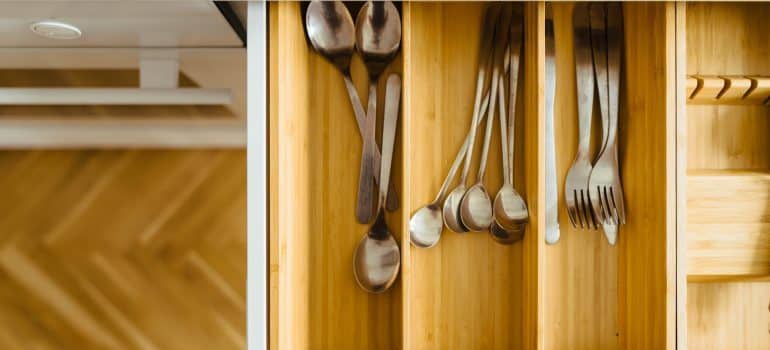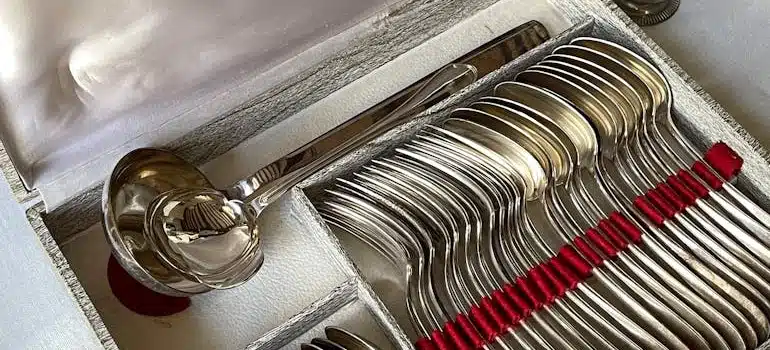Guide to packing silverware when moving
You packed your plates and glasses carefully, but what about the silverware? That’s where damage often happens. Packing silverware when moving takes more than a drawer tray and some tape. Without a plan, you risk bent prongs, dull blades, or lost pieces. Our practical Pro Movers Miami guide shows you how to do it right using simple, affordable supplies!
Start with sorting and decluttering
Before you wrap anything, remove all your silverware from drawers, organizers, or trays. Lay it out on a clean surface. Sort it by category:
- Everyday flatware
- Serving utensils
- Sharp knives
- Antique or silver-plated sets
Next, evaluate what you want to take with you. Discard damaged or rusty items. Donate extra sets you no longer use. Fewer items mean fewer boxes, less wrapping, and easier unpacking. Cleaning is essential at this stage. Wash every piece with mild soap and dry it completely. Moisture left on silverware leads to tarnishing, especially with real silver.

Supplies you need for packing silverware when moving
The materials you use matter. The right packing supplies help prevent damage and keep items from shifting during transport. Use the list below to get everything ready before you start:
- Unprinted packing paper or acid-free tissue
- Bubble wrap (for knives and delicate items)
- Cardboard sleeves (for sharp knife blades)
- Zip-top bags or plastic containers
- Rubber bands or masking tape
- Small to medium moving boxes
- Labels and a permanent marker
- Anti-tarnish strips (for real silver)
Avoid newspapers because they transfer ink and can damage silver. Never use plastic wrap directly on silver items because it can trap moisture.
Wrap silverware by type
Now that everything is sorted and cleaned, group your silverware by type. This step prevents scratching and speeds up unpacking.
Flatware (forks, spoons, butter knives)
Flatware makes up the bulk of most kitchen drawers, so packing it efficiently keeps things simple on both ends of the move. Keep similar pieces together and follow these steps to protect them during transport:
- Bundle 4–6 of the same item.
- Wrap the bundle in packing paper.
- Fold tightly and secure with tape or a rubber band.
- Place the wrapped bundle in a labeled zip-top bag.
- Repeat for each type of item.
Keep your bundles uniform. It keeps the box balanced and helps you repack drawers faster.
Serving utensils
You should wrap larger pieces like ladles, spatulas, and salad tongs individually. Their odd shapes bend easily or puncture thin packing. Use two layers of packing paper for each item, and add bubble wrap if the piece feels heavy.
Pack knives with added care
Knives pose a safety risk if packed improperly. Always wrap knives individually and label them clearly. But first:
- Slide the blade into a folded piece of cardboard.
- Wrap the entire knife in bubble wrap.
- Use packing tape to secure the bundle.
- Label it “Sharp – Handle With Care.”
Never place loose knives in a bag or box! They can cut through the wrapping, damage other items, or injure whoever unpacks them.

How to pack antique or silver-plated flatware
Packing silverware when moving requires extra steps or assistance from antique movers if you’re handling real silver or heirloom pieces:
- Wrap each item individually in acid-free tissue.
- Add an anti-tarnish strip to each bundle.
- Use a soft cloth pouch, jewelry roll, or lined case if available.
- Place wrapped pieces in a small rigid box.
- Pad with soft material like microfiber cloth or foam inserts.
- Label the box clearly and mark it as valuable.
Do not allow silver-plated items to touch each other. Friction causes scratches. Real silver also reacts poorly to air exposure, so sealing it properly is key.
Choose the right boxes
Silverware is heavy. Avoid large boxes that can rip under the weight or become hard to carry. Use small to medium boxes and keep the contents under 40 pounds. Here’s how to pack the box:
- Line the bottom with crumpled paper or bubble wrap.
- Place wrapped silverware bundles flat, by type.
- Add padding between layers if stacking.
- Fill gaps with paper so nothing shifts.
- Add a final top layer of padding before closing.
- Seal with strong tape on all seams.
Label each box clearly so movers and unpackers know what’s inside. Write “Kitchen – Silverware – Heavy” on at least two sides. If the box contains knives, also add “Sharp items inside” to prevent accidents.
Keep valuables with you
Do not ship expensive silverware sets with the rest of your moving load. Take them with you in your personal vehicle. Use a small lockable box or backpack compartment. For interstate or long-distance moves, insure valuable sets separately. Take photos of each item as documentation in case of damage or loss.
Unpacking silverware in your new home
Open your silverware boxes within the first 24 hours after arriving. Sealed boxes can trap humidity, which may lead to tarnish on silver or rust on stainless steel. Lay a clean towel on your countertop and unwrap each bundle carefully.
Wash or polish the items again if needed, then sort everything into drawers or trays by type. Take a moment to check that nothing is missing or damaged. If you plan to move again or store items long term, keep the wrapping materials in good condition for reuse.

Common FAQ about packing silverware when moving
Packing silverware when moving can raise a few sharp questions, so let’s clear them up before they scratch the surface of your move.
Q: Should I use plastic wrap to pack silverware?
A: No. It traps moisture and can damage silver-plated items. Use paper instead.
Q: Can I pack silverware in the drawer tray?
A: Yes, but wrap the top with paper and tape it securely. Then cushion the tray inside a box.
Q: Do I really need to label boxes with knives?
A: Yes. Knives can hurt people or damage items if unwrapped without warning.
Q: Do I need moving insurance for my silverware?
A: If you’re moving valuable or antique silverware, consider extra moving insurance. Standard mover coverage may not fully reimburse loss or damage. For rare sets, take photos and ask about full-value protection or a separate policy.
Q: What’s the best way to store silver long-term after a move?
A: Use anti-tarnish cloth or airtight containers. Keep silver away from humidity and always clean it before storing.
The last box you’ll want to open wrong
Silverware might be one of the smallest things you pack, but it’s also one of the easiest to damage or lose. Bent forks, dull blades, or tarnished silver aren’t just annoying; they’re avoidable. A smart packing process keeps everything intact and organized.
As you’re packing silverware when moving, group by type, wrap tightly, label clearly, and use boxes that can handle the weight. Take special care with knives and anything valuable, or rely on white glove packing services. Once you arrive, unpack early, rinse if needed, and get everything back in place fast. No guesswork. No cuts. And no missing teaspoons.
